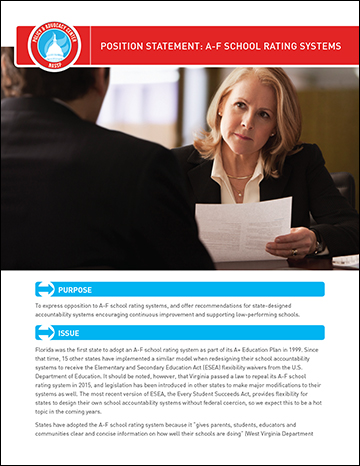To express opposition to A-F school rating systems, and offer recommendations for state-designed accountability systems encouraging continuous improvement and supporting low-performing schools.
Florida was the first state to adopt an A-F school rating system as part of its A+ Education Plan in 1999. Since that time, 15 other states have implemented a similar model when redesigning their school accountability systems to receive the Elementary and Secondary Education Act (ESEA) flexibility waivers from the U.S. Department of Education. It should be noted, however, that Virginia passed a law to repeal its A-F school rating system in 2015, and legislation has been introduced in other states to make major modifications to their systems as well. The most recent version of ESEA, the Every Student Succeeds Act, provides flexibility for states to design their own school accountability systems without federal coercion, so we expect this to be a hot topic in the coming years.
States have adopted the A-F school rating system because it “gives parents, students, educators and communities clear and concise information on how well their schools are doing” (West Virginia Department of Education). Proponents also argue that letter grades are transparent and objective, and that they force improvements in low-performing schools. They also claim that closing schools that receive low grades or allowing parents to remove their children from those schools ultimately ensures that only high-performing schools survive.
Even with the proliferation of A-F school rating systems in states, there has been very little research conducted to determine the reliability or validity of using them for state accountability. The only known reports were conducted in 2013 by The University of Oklahoma and Oklahoma State University researchers who were highly critical of Oklahoma’s A-F school rating system. They argued that basing a letter grade almost exclusively on test scores does not account for numerous factors that contribute to school performance, including many outside of educators’ control. They also noted that A-F grades were not productive for school improvement because they did not explain the how or why of low performance, and the system did nothing to build the capacity of schools or educators.
Researchers at The Education Trust also found that a single letter grade for schools does not tell the whole story, and could mask the low performance of certain student subgroups. It could also hide high performance and growth among students, and other indicators that a school is headed in the right direction. Some opponents have also expressed concern that assigning a low grade to a school or district could make it more difficult to attract and retain highly effective teachers and school leaders who could have a positive impact on the students and the community. And although policymakers hoped that these systems would empower parents to make decisions about their children’s education, low grades “are more likely to alienate parents from democratic participation in the education of their children than to promote healthy school involvement” (Howe; Murray, January 2015).
Guiding Principles
- No decision about a school’s performance should be based on a single data point or a single test. The focus of education must be on academic learning and growth, as opposed to an isolated performance on a single assessment.
- A valid measure of school performance should be comprehensive, accounting for school processes, conditions, practices, and outcomes.
- NASSP believes that quantitative and qualitative data should inform decisions at the classroom, school building, and district levels.
- Information from any accountability systems should be used for improvement, not for high-stakes consequences.
Recommendations
Recommendations for Federal Policymakers
- Conduct research on state accountability systems and promote best practices on student achievement measures, interventions, support for low-performing schools, and communication strategies for explaining school performance ratings.
- Highlight schools that are successfully educating high-need students and closing achievement gaps.
Recommendations for State Policymakers
- Consult assessment and evaluation experts in designing or revising school accountability systems.
- Provide district and school leaders, teachers, and other education stakeholders opportunities to participate in and provide feedback on the development of a school accountability system.
- Rather than a single letter grade, develop report cards for schools and districts using multiple performance indicators over multiple years and providing useful information for educators, parents, and communities.
- Discontinue the use of proficiency-based performance scores, which, in the past, caused schools and districts to focus on “bubble kids” rather than the academic achievement and growth of all students.
- Require school report cards to include performance-based measures that are aligned with state standards, and measure individual student growth from year to year. NASSP suggests the following:
- State assessments or end-of-course exams in English, language arts, mathematics, and science
- Assessments aligned with high school and college entrance requirements (ACT, SAT, etc.)
- High school graduation rates, including extended-year graduation rates that demonstrate the progress of schools working with struggling students
- Attendance rates
- School impact reports on closing achievement gaps
- Access to accelerated learning opportunities such as AP courses
- Reclassification of English language learner and special education students
- Communicate the limitations of the accountability system and warn against the inappropriate use of high-stakes decision making.
- Provide additional funding and support for low-performing schools.
Recommendations for District Leaders
- Rather than punish low-performing schools, work with the school improvement team to develop a school plan that prioritizes areas of improvement based on the results of a comprehensive needs assessment and capacity analysis.
- Provide ongoing intensive technical assistance and related support to low-performing schools.
- Focus efforts on attracting and retaining highly effective teachers and school leaders in low-performing schools, and provide all educators with extensive job-embedded professional development opportunities.
- Ensure that school leaders in low-performing schools have autonomies over their calendars, staffing, budgets, and curricular decisions.
- Provide schools with timely performance information that allows them to make adjustments during the school year.
- Publish information about school and district report cards in a way that is easily understood by parents and community members.
Recommendations for School Leaders
- Advocate to state and school leaders about changes you would like to see in your state’s current accountability system.
Resources
Ableidinger, J. (Spring 2015). A is for affluent. Public School Forum of North Carolina. Retrieved from http://www.ncforum.org/wp-content/uploads/2013/05/A-is-for-Affluent-Issue-Brief-Format.pdf.
Education Commission of the States (June 2014). Rating states, grading schools. Retrieved from http://www.ecs.org/clearinghouse/01/12/53/11253.pdf.
Howe, K. & Murray, K. (January 2015). Why school report cards merit a failing grade. National Education Policy Center. Retrieved from http://nepc.colorado.edu/publication/why-school-report-cards-fail.
REL Midwest Reference Desk (April 2014). State use of A-F accountability models. Retrieved from http://www.relmidwest.org/sites/default/files/RDR2014_04_QP9659756_A-F_accountability_Web.pdf.
StudentsFirst (September 2013). Empowering parents with data: school report cards. Retrieved from.
The Oklahoma Center for Education Policy and The Center for Educational Research and Evaluation (January 2013). An examination of the Oklahoma State Department of Education’s A-F report card. The University of Oklahoma and Oklahoma State University.
The Oklahoma Center for Education Policy and The Center for Educational Research and Evaluation (October 2013). Oklahoma school grades: hiding “poor” achievement. The University of Oklahoma and Oklahoma State University.
Ushomirsky, N, Williams, D, Hall, D (October 2014). Making sure all children matter: getting school accountability right. Retrieved from https://files.eric.ed.gov/fulltext/ED566660.pdf.
Wagner, L. (February 4, 2015). Do A-F school grades measure progress or punish the poor? NC Policy Watch. Retrieved from http://www.ncpolicywatch.com/2015/02/04/do-a-f-school-grades-measure-progress-or-punish-the-poor/.
West Virginia Department of Education (date unknown). West Virginia’s A through F school grading system FAQs. Retrieved from https://wvde.state.wv.us/federal-programs/resources/documents/9-A-FFAQ.pdf.


